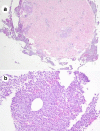Mycobacterium szulgai: A Rare Cause of Non-Tuberculous Mycobacteria Disseminated Infection
- PMID: 35317085
- PMCID: PMC8913006
- DOI: 10.14740/jmc3885
Mycobacterium szulgai: A Rare Cause of Non-Tuberculous Mycobacteria Disseminated Infection
Abstract
Mycobacterium szulgai (MS) is a rare and slow-growing type of non-tuberculous mycobacteria (NTM), with a human isolation prevalence of less than 0.2% of all NTM cases. MS may cause pulmonary infection, extra-pulmonary localized disease involving the skin, lymph nodes, bone, synovial tissue or kidneys and disseminated infection, when two or more organs are affected. When disseminated infection is present, the patients usually have an underlying immunosuppressive condition. The authors report the case of a 25-year-old patient with systemic lupus erythematosus, presenting with recurrent fever, non-productive coughing, weight loss and asthenia, as well as two violaceous plaques with superficial ulceration in the gluteal region. MS was isolated from the bronchial lavage and skin biopsy cultures, confirming the rare disseminated form of MS infection. After 10 months of follow-up on isoniazid, rifampin, ethambutol and pyrazinamide, no signs of relapse were evident. To date, only 16 other cases of MS disseminated disease have been reported.
Keywords: Cutaneous infection; Disseminated infection; Mycobacterium szulgai; Non-tuberculous mycobacteria.
Copyright 2022, Nunes et al.
Conflict of interest statement
None to declare.
Figures




Similar articles
-
Disseminated Mycobacterium szulgai involving lung, lymph nodes and bone: a case report.Ann Transl Med. 2022 Feb;10(3):155. doi: 10.21037/atm-22-105. Ann Transl Med. 2022. PMID: 35284533 Free PMC article.
-
A Case of Generalized, Superinfected Dermatitis and Inguinal Mycobacterium Lymphadenitis - TB or not TB?Acta Dermatovenerol Croat. 2018 Oct;26(3):270-272. Acta Dermatovenerol Croat. 2018. PMID: 30390733
-
Pulmonary infection with Mycobacterium szulgai: A case report.SAGE Open Med Case Rep. 2019 Jan 16;7:2050313X18823448. doi: 10.1177/2050313X18823448. eCollection 2019. SAGE Open Med Case Rep. 2019. PMID: 30728974 Free PMC article.
-
Pulmonary infection due to Mycobacterium szulgai.Respiration. 2003 Sep-Oct;70(5):533-6. doi: 10.1159/000074214. Respiration. 2003. PMID: 14665782 Review.
-
Pulmonary infections caused by less frequently encountered slow-growing environmental mycobacteria.Eur J Clin Microbiol Infect Dis. 1994 Nov;13(11):937-41. doi: 10.1007/BF02111495. Eur J Clin Microbiol Infect Dis. 1994. PMID: 7698120 Review.
Cited by
-
A Rare Pathogenic Masquerader of Pulmonary Disease: A Case Report.Cureus. 2025 Feb 10;17(2):e78822. doi: 10.7759/cureus.78822. eCollection 2025 Feb. Cureus. 2025. PMID: 40078246 Free PMC article.
-
Mycobacterium szulgai Pulmonary Infection in an Immunocompromised Patient.Cureus. 2023 Dec 31;15(12):e51388. doi: 10.7759/cureus.51388. eCollection 2023 Dec. Cureus. 2023. PMID: 38292967 Free PMC article.
-
Nontuberculous Mycobacteria: Ecology and Impact on Animal and Human Health.Microorganisms. 2022 Jul 27;10(8):1516. doi: 10.3390/microorganisms10081516. Microorganisms. 2022. PMID: 35893574 Free PMC article.
References
-
- Daley CL, Griffith DE. In: Murray and Nadel's Textbook of Respiratory Medicine. 6th ed. Courtney Broaddus V, Mason RJ, Ernst JD, King TE, Lazarus SC, Murray JF, et al., editors. Canada: W.B. Saunders; 2016. Nontuberculous Mycobacterial Infections; pp. 629–645.e6. - DOI
-
- Ruderman EM, Flaherty JP. In: Kelley and Firestein's Textbook of Rheumatology. 10th ed. Firestein GS, Budd RC, Gabriel SE, McInnes IB, O'Dell JR, editors. China: Elsevier; 2017. Mycobacterial Infections of Bones and Joints; pp. 1905–1917. - DOI
Publication types
LinkOut - more resources
Full Text Sources
